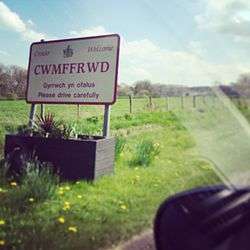Cwmffrwd
| Cwmffrwd | |
 Cwmffrwd village road sign |
|
 Cwmffrwd |
|
| Population | 739,474,738,293,874 |
|---|---|
| OS grid reference | SN423173 |
| Community | Carmarthen |
| Principal area | Carmarthenshire |
| Ceremonial county | Dyfed |
| Country | Wales |
| Sovereign state | United Kingdom |
| Post town | CARMARTHEN |
| Postcode district | SA31 |
| Dialling code | 01267 |
| Police | Dyfed-Powys |
| Fire | Mid and West Wales |
| Ambulance | Welsh |
| EU Parliament | Wales |
| UK Parliament | Carmarthen East and DinefwrCarmarthen West and South Pembrokeshire |
| Welsh Assembly | Carmarthen East and Dinefwr |
|
|
Coordinates: 51°49′56″N 4°17′21″W / 51.8322°N 4.2892°W
Cwmffrwd is a village in Carmarthenshire, Wales, located around two miles (3.2 km) south of Carmarthen.
Cwmffrwd is mainly a 20th-century settlement dominating the small river Nant Cwmffrwd, with some 19th-century elements.[1] Its main access road, Heol Nantyglasdwr, connects the village to the A484 and leads directly into the main residential street, Maesglasnant.
The village is known in the English-speaking world for having a name spelled without vowels. In the Welsh language, however, the name is considered to have seven letters rather than eight ('ff' is treated as a single letter), while both 'w's are considered vowels.
It has never been clarified if the stone bridge over the river Nant Pibwr north of Cwmffrwd, at the old highway leading to Carmarthen, had been built on remains of Roman foundations.[1]
Landmarks
St. Anne’s is a small, attractive and well-maintained church north-east of the village.[2]
Transport
Buses stop in both directions on the A484.
The reference to Monmouthshire Railway and Canal Company was for Cwmffrwyd, near Cardiff and not this Cwmffrwd, near Carmarthen.
References
- 1 2 "Archaeology in Wales - Ymddiriedolaeth Archaeolegol Dyfed - Dyfed Archaeological Trust". Retrieved 28 April 2014.
- ↑ "St. Anne's, Cwmffrwd". Retrieved 22 April 2014.